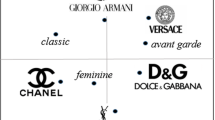Abstract
This paper presents a multidimensional scaling (MDS) methodology (vector model) for the spatial analysis of preference data that explicitly models the effects of unfamiliarity on evoked preferences. Our objective is to derive a joint space map of brand locations and consumer preference vectors that is free from potential distortion resulting from the analysis of preference data confounded with the effects of consumer-specific brand unfamiliarity. An application based on preference and familiarity ratings for ten luxury car models collected from 240 consumers who intended to buy a luxury car within a designated time frame is presented. The results are compared with those obtained from MDPREF, a popular metric vector MDS model used for the scaling of preference data. In particular, we find that the consumer preference vectors obtained from the proposed methodology are substantially different in orientation from those estimated by the MDPREF model. The implications of the methodology are discussed.
Similar content being viewed by others
References
Alba, Joseph W., and J. Wesley Hutchinson. (1987). “Dimensions of Consumer Expertise,”Journal of Consumer Research 13 (March), 411–454.
Anderson, Norman H. (1981).Foundations of Information Integration Theory. New York: Academic Press.
Bauer, Raymond. (1960). “Consumer Behavior as Risk Taking.” InDynamic Marketing in a Changing World R. Hancock (ed.), Chicago: American Marketing Association.
Bettman, James R. (1973). “Perceived Risk and its Components,”Journal of Marketing Research 10 (May), 184–189.
Carroll, J. Douglas, and J. J. Chang. (1964). “Nonparametric Multidimensional Analysis of Paired Comparisons Data,” presented at the Joint Meet. Psychom. Psychon. Soc., Niagara Falls.
Chatterjee, Rabikar, and Jehoshua Eliashberg. (1990). “The Innovation Diffusion Process in a Heterogenous Population: A Micromodeling Approach,”Management Science 36 (September), 1057–1079.
Currim, Imran S., and Rakesh K. Sarin. (1983). “A Procedure for Measuring and Estimating Consumer Preferences Under Uncertainty,”Journal of Marketing Research 20 (August), 249–256.
DeSarbo, Wayne S., Geert de Soete, and Kamel Jedidi. (1987). “Probabilistic Multidimensional Scaling Models for Analyzing Consumer Choice Behavior,”Communication and Cognition 20 (1), 93–116.
DeSarbo, Wayne S., and Vithala R. Rao. (1986). “A Constrained Unfolding Methodology for Product Positioning,”Marketing Science 5 (Winter), 1–19.
De Soete, Geert, and J. Douglas Carroll. (1983). “A Maximum Likelihood Method for Fitting the Wandering Vector Model,”Psychometrika 48 (December), 553–566.
De Soete, Geert, J. Douglas Carroll, and Wayne S. DeSarbo. (1986). “The Wandering Ideal Point Model: A Probabilistic Multidimensional Unfolding Model for Paired Comparisons Data,”Journal of Mathematical Psychology 30 (March), 28–41.
Eliashberg, Jehoshua, and John R. Hauser. (1985). “A Measurement Error Approach for Modeling Consumer Risk Preference,”Management Science 15 (January), 1–25.
Gatignon, Hubert. (1984). “Toward a Methodology for Measuring Advertising Copy Effects,”Marketing Science 3 (Fall), 308–326.
Green, Paul E., and Frank J. Carmone. (1970).Multidimensional Scaling and Related Techniques in Marketing Analysis. Boston, MA: Allyn and Bacon, Inc.
Howard, John A. (1977).Consumer Behavior. New York: McGraw-Hill.
Kahnemann, Daniel, and Amos Tversky. (1979). “Prospect Theory: An Analysis of Decision Unider Risk,”Econometrica 47 (March), 263–291.
Keeney, Ralph L., and Howard Raiffa. (1976).Decisions with Multiple Objectives: Preferences and Value Tradeoffs. New York: John Wiley & Sons.
Lee, Wayne. (1976).Decision Theory and Human Behavior. New York: Wiley.
MacKay, David B. (1989). “Probabilistic Multidimensional Scaling: An Anisotropic Model for Distance Judgments,”Journal of Mathematical Psychology 33 (June), 187–205.
MacKay, David B., and Joseph L. Zinnes. (1986). “A Probabilistic Model for the Multidimensional Scaling of Proximity and Preference Data,”Marketing Science 5 (Fall), 325–344.
Meyer, Robert J. (1981). “A Model of Multiattribute Judgments Under Attribute Uncertainty and Informational Constraint,”Journal of Marketing Research 18 (November), 428–441.
Meyer, Robert J., and Arvind Sathi. (1985). “A Multiattribute Model of Consumer Choice During Product Learning,”Marketing Science 4 (Winter), 41–61.
Pratt, John W. (1964). “Risk Aversion in the Small and in the Large,”Econometrica 41, 35–49.
Ramsay, J. O. (1977). “Maximum Likelihood Estimation in Multidimensional Scaling,”Psychometrika 42 (June), 241–266.
Roberts, John H., and Glen L. Urban. (1988). “Modeling Multiattribute Utility, Risk, and Belief Dynamics for New Consumer Durable Brand Choice,”Management Science 34 (February), 167–185.
Slovic, Paul, and Douglas MacPhillamy. (1974). “Dimensional Commensurability and Cue Utilization in Comparative Judgment,”Organizational Behavior and Human Performance 11 (April), 172–194.
Sujan, Mita. (1985). “Consumer Knowledge: Effects in Evaluation Strategies Mediating Consumer Judgments,”Journal of Consumer Research 12 (June), 31–46.
Takane, Yoshio. (1978). “A Maximum Likelihood Method for Nonmetric Multidimensional Scaling: 1. The Case in Which All Empirical Pairwise Orderings are Independent — Theory,”Japanese Psychological Research 20, 7–17.
Wright, Peter, and Barton A. Weitz. (1977). “Time Horizon Effects on Product Evaluation Strategies,”Journal of Marketing Research 14 (November), 429–443.
Yates, J. Frank, Carolyn M. Jagacinski, and Mark D. Faber. (1978). “Evaluation of Partially Described Multiattribute Options,”Organizational Behavior and Human Performance 21 (April), 240–251.
Zinnes, Joseph L., and David B. MacKay. (1983). “Probabilistic Multidimensional Scaling: Complete and Incomplete Data,”Psychometrika 48 (March), 27–48.
Zinnes, Joseph L., and David B. MacKay. (1987). “Probabilistic Multidimensional Analysis of Preference Ratio Judgments,”Communication and Cognition 20 (1), 17–44.
Author information
Authors and Affiliations
Additional information
The authors gratefully acknowledge helpful comments from the editor and two anonymous reviewers, and also from Michael D. Johnson and Robert J. Meyer. They also thank Michael Kusnick and Robert Kleinbaum for their assistance in conducting the survey.
Rights and permissions
About this article
Cite this article
Chatterjee, R., Desarbo, W.S. Accommodating the effects of brand unfamiliarity in the multidimensional scaling of preference data. Marketing Letters 3, 85–99 (1992). https://doi.org/10.1007/BF00994083
Received:
Revised:
Issue Date:
DOI: https://doi.org/10.1007/BF00994083




